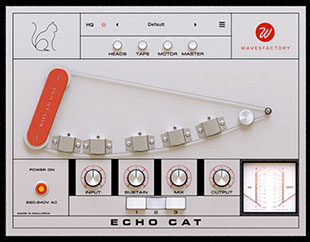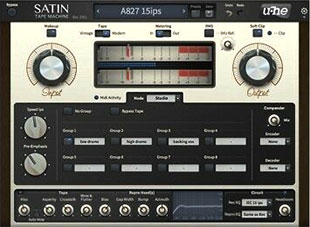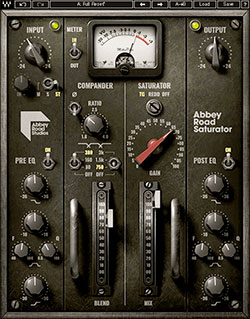![]() When professional digital audio made its entrance, the limitations of early technology combined with the excitement of some advocates made it a soft target for purists and sceptics. Then, as the tech found its feet and its potential became tangible, there was no going back.
When professional digital audio made its entrance, the limitations of early technology combined with the excitement of some advocates made it a soft target for purists and sceptics. Then, as the tech found its feet and its potential became tangible, there was no going back.
Digital audio’s eventual coming of age, however, brings new desire for the nuances of analogue.
Early on, digital was damned for its ‘harsh’ treatment of audio – the comforting noise floor and shaped HF of analogue componentry and mechanics were gone, replaced by surgical 20Hz-20kHz clarity. It was audio, but not as we knew it, and so the quest to recover lost charm began.
 It’s often proved difficult, if not impossible to make a new technology impersonate specific characteristics of an old one. The behaviour of new technology brings its own ‘character’ (as, for example, with early digital delays), almost diametrically distancing it from that of its predecessor. The constantly increasing power of DSP, however, had promise.
It’s often proved difficult, if not impossible to make a new technology impersonate specific characteristics of an old one. The behaviour of new technology brings its own ‘character’ (as, for example, with early digital delays), almost diametrically distancing it from that of its predecessor. The constantly increasing power of DSP, however, had promise.
An obvious means of adding analogue character to digital recording is to add analogue equipment into the workflow in the form of preamps, outboard and tape – hybrid working. This works – to differing degrees, dependent on the specifics of a set-up – as evidenced by the engineers and producers who use it, and successful recordings made in this way. But if you’re used to working ‘in-the-box’, it’s clumsy, bulky and expensive.
The alternative is to use plug-ins to manufacture analogue artefacts within a DAW set-up. And to this end, we have seen a proliferation of ‘saturation’ plug-ins tendered by a wide range of authors. Problem solved?
What analogue electronics do to audio signals appears to elude many saturation plug-in users, however, frequently being simplistically termed as ‘adding analogue warmth’. I recently saw an indication of the level of this misunderstanding in an online discussion of the differing effects produced by tubes, valves and tape.
Tubes and valves
Without the ability to run a hybrid set-up, there is no doubt that today’s saturation plug-ins succeed where ‘valve emulating’ transistor circuitry of the first transistor guitar amps did not.
Valves (tubes), transistors, transformers and tape all share nonlinear behaviour – their compression and distortion are inconsistent, selectively affecting areas of the frequency range dependent upon how hard they are driven by the audio signal level.
Digital clipping, in contrast, is linear with a more precisely defined clipping point.
Taken in isolation, tube saturation introduces even-order harmonics also adding a subtle compression. However, when pushed hard, tubes can have an aggressive edge. In contrast, transistor saturation introduces odd-order harmonics and a form of hard clipping compression. In its simplest terms, tape saturation describes a state where the voltage offered at the record head has exceeded the tape’s ability to record it – especially louder, higher frequencies. Used widely in analogue electronics, transformers also introduce nonlinearities and harmonic distortion to the signal, resulting from the combination of hysteresis effects at low signal levels and saturation at higher levels.
 When we begin to assemble analogue systems, these elements quickly combine and interact, producing more complex results – this happens within individual pieces of kit, and as the cumulative result of a complete signal chain.
When we begin to assemble analogue systems, these elements quickly combine and interact, producing more complex results – this happens within individual pieces of kit, and as the cumulative result of a complete signal chain.
Should wow and flutter, tape stretching, crinkling and ageing be regarded as part of a ‘tape saturation processor’? The short answer is clearly no, as they are not facets of saturation. They are, however, a part of the system that also brings that ‘analogue warmth’ to non-digital recordings both old and new.
In certain tape emulation settings, they are every bit as desirable as saturation, if not more so. This is certainly the case with stompox resurrections of tape echoes such as the Maestro EchoPlex, Binson EchoRec and Roland Space Echo. It’s fair to regard these as effects boxes, rather than processors, but let’s linger on tape echo as a performance effect for a moment. Better still; let’s take a look at my first tape echo…
When it appeared in 1958, the Watkins Copicat was the first repeat-echo machine manufactured as a single, portable unit. It used quarter-inch tape (mono), and had three switchable heads – originally, erase was achieved by permanent magnets inside the tensioning arm before a dedicated erase head appeared, and was promptly modded to allow it to be defeated by some users.
After the Shadows hit ‘Apache’ championed use of a Fender Stratocaster, Vox AC30 and Watkins Copicat, the first 100 units that Watkins made sold out on the first day. Mine was a MkIII/IV. Looking back, I feel bad that I rather took it for granted and have made Wavesfactory’s Echo Cat plug-in a welcome part of my recording set-up in its stead.
In general, recreations of specific tape echo units – such as Catalinbread’s Belle Epoch and EchoRec pedals, and Strymon’s El Capistan that pair analogue circuit elements with DSP tape models – belong in the stompbox universes, where saturation is rarely mentioned.
Reel life
The SPL TwinTube offers a good point from which to climb back into the box, as the company’s Machine Head was possibly the first hardware emulation of tape saturation when it appeared in 1998. A good indicator of the direction of travel, the current plug-in – with independent control over tube saturation and harmonic content – is just one of many plug-in ‘saturators’ now available.
 Among the more tape-focused of these are Black Rooster’s Magnetite, UAD’s Studer A800, Waves’ J37 and Kramer Master Tape, as well as the Waves Abbey Road Mastering Chain (based on the EMI TG12410 Transfer Console).
Among the more tape-focused of these are Black Rooster’s Magnetite, UAD’s Studer A800, Waves’ J37 and Kramer Master Tape, as well as the Waves Abbey Road Mastering Chain (based on the EMI TG12410 Transfer Console).
Stepping back to 1965, for a moment, Abbey Road Studios took delivery of four Studer J37s at a cost of £8,000 each and used them on The Beatles Sgt Pepper’s album among many others. The Waves emulation offers control over wow and flutter, noise and saturation amount, as well as three emulated oxide tape formulae at either 15ips or 7.5ips and three J37 models.
While not modelled on a specific machine, U-he’s Satin is not coy about its tape aspirations, offering control over hiss, crosstalk and wow and flutter, a tape EQ ‘bump’ and options on tape types and speed. In the best traditions of a studio tape deck, it also has stereo delay and tape flange modes, including through-zero flanging. Black Rooster’s Magnetite, meanwhile, promises ‘authentic tape warmth’ with its options on tape speed, tape formulation, bias and noise reduction, alongside a combined wow and flutter mix. And UAD’s Studer A800 reckons to offer a faithful model the circuit path of the A800 machine at Allen Sides’ Ocean Way Studios to users of UAD hardware, Apollo interfaces and Luna Recording System.

Other saturation plug-ins are rather more shy when it comes to identifying saturation specifics, such as the Sonnox Oxford Inflator and Waves’ Abbey Road Saturator, while others expand the ‘saturation brief’ with additional functions, such as iZotope’s Trash 2 with its filters, multi-band dynamics, waveshapers, LFOs and envelopes, and FabFilter Saturn 2 with its multi-band saturation.
There are more – many more – saturation options for the DAW user feeling nostalgic about analogue technology’s shortcomings. Some, principally those emulating tape and tape transport, share common parameters while others are more vague in the inspiration of their analogue warmth. Few are specific about circuitry such as transformers.
Ultimately, if you’re about to insert that saturator across your master bus it either means you want to borrow some of yesterday’s vibes or you’re simply curious to see what recordings sounded like in the days before digital. Do you care about hysteresis or the build-up of hiss when your four tracks are all full and bouncing is your only option?
Either way, to me it seems inescapable that ‘analogue saturation’ processing could readily become part of a DAW bundle – a simple option to be switched in at various points in the signal flow, in a similar manner to limiting and EQ.
See also: Echoes from the Past